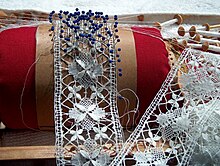User:AvaDarlene/Mundillo

Mundillo is a craft of handmade bobbin lace that is cultivated and honored on the island of Puerto Rico. The term 'mundillo' means 'little world', referring to the cylindrical pillow on which the lace maker ('Mundillista') weaves intricate designs. The decorative lace is created using wooden bobbins about the diameter of a pencil, which are wound with thread that is twisted and crossed to form a pattern. Depending on the pattern, as few as two dozen or as many as several hundred bobbins may be used.
In addition to its use as edging and borders on tablecloths and handkerchiefs, and for traditional shirt collars and trim, mundillo is also used to decorate items for special occasions, such as wedding dresses, baptismal gowns, and the cloths used to adorn religious icons. It is said that it was once common for lovers to exchange mundillo lace with romantic inscriptions.[1]
Bobbin lace was brought to Puerto Rico from Spain, where it had thrived in major commercial markets as well as a cottage industry in Galicia, Castilla, and Catalonia. In Spain, lace is called encaje, because it was worked on separately and then joined to material (the Spanish word for "join" is encajar). In Puerto Rico, the towns of Moca, Isabela, and Aguadilla, all in the northwestern part of the island, are famous for mundillo lace. In Moca, commonly known as the Capital or cradle of Mundillo, there is an annual festival dedicated to the handmade lace as well as a museum, El Museo Del Mundillo.
See Also[edit]
References[edit]
- ^ Martinez, Elena (Fall/Winter). "The Queen of Mundillo". Voices: The Journal of New York Folklore. 29. Retrieved 23 March 2011.
{{cite journal}}: Check date values in:|date=and|year=/|date=mismatch (help)
External Links[edit]
Rosa Elena Egipciaco: Lace and Lacemaking
Rosa Elena Egipciaco is a master Mundillo lacemaker. In addition to being part of the long lacemaking tradition of her hometown of Moca, Puerto Rico, she claims a place in a much larger, much longer tradition of Spanish and European lacemaking.
